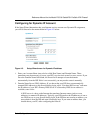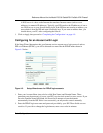
Reference Manual for the Model FVS318 Cable/DSL ProSafe VPN Firewall
4-8 Basic Configuration
Note: You will no longer need to launch the ISP’s login program on your PC in order to access
the Internet. When you start an Internet application, your firewall will automatically log you
in.
3. Domain Name Server (DNS) Address: If you know that your ISP does not automatically
transmit DNS addresses to the firewall during login, select “Use these DNS servers” and enter
the IP address of your ISP’s Primary DNS Server. If a Secondary DNS Server address is
available, enter it also.
A DNS server is a host on the Internet that translates Internet names (such as www
addresses) to numeric IP addresses. Typically your ISP transfers the IP addresses of one or
two DNS servers to your firewall during login. If the ISP does not transfer an address, you
must obtain it from the ISP and enter it manually here. If you enter an address here, you
should reboot your PCs after configuring the firewall.
4. ClickonApply,thenproceedto“Completing the Configuration“ on page 4-9.
Manual Configuration
You can manually configure the firewall in the Basic Settings menu shown in Figure 4-2 using
these steps:
1. Select whether your Internet connection requires a login.
Select ‘Yes’ if you normally must launch a login program such as Enternet or WinPOET in
order to access the Internet.
2. Enter your Account Name (may also be called Host Name) and Domain Name. These
parameters may be necessary to access your ISP’s services such as mail or news servers.
3. (If displayed) Enter the PPPoE login user name and password provided by your ISP. These
fields are case sensitive. If you wish to change the login timeout, enter a new value in minutes.
Note: You will no longer need to launch the ISP’s login program on your PC in order to access
the Internet. When you start an Internet application, your firewall will automatically log you
in.
4. Internet IP Address: If your ISP has assigned you a permanent, fixed (static) IP address for
your PC, select “Use static IP address”. Enter the IP address that your ISP assigned. Also enter
the netmask and the Gateway IP address. The Gateway is the ISP’s router to which your
firewall will connect.


















